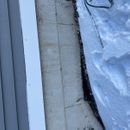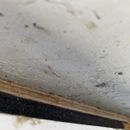Foundation Staining After Storm
Hello all, After some wild wind and rain last week in Midcoast Maine I noticed some staining on the south side of my foundation. There are a few spots elsewhere, but the bulk of it is located on that side. Assembly is vinyl over Zip with a 5/8 rain screen. basement is insulated with closed cell foam up the walls and rim. The rest of the house is Roxul. I can see no inward signs of moisture anywhere in the house. I have also peeled back the siding in a few spots and see no signs of water damage.
Could this be a failure of the zip tape somewhere further up the wall that allowed the water to get in and run down the interior side of the sheathing? looking under the pvc trim you’ll notice that it doesn’t show any signs of mold or rot. It was never sealed to the foundation wall. We have been in here for 2 and a half years and haven’t changed anything recently.
Appreciate any thoughts
GBA Detail Library
A collection of one thousand construction details organized by climate and house part











Replies
That was quite a storm, with wind from the southeast which is unusual for Maine unless you're right on the coast and get onshore winds. When storms come from a non-standard direction they can highlight issues that are usually hidden. No cladding is impervious so you likely had some rain get past it to your WRB, and also around windows and doors. If you have a vented roof, wind-sucked rain can get into the roof as well.
Dark stains often include tannins from wood, or oils from petroleum products such as asphalt felt or ice and water shield. Water running down the inside of Zip sheathing is one potential source, but it wouldn't be the first place I'd look. What's the detail where the wall meets the roof? Is the roof vented? Are there windows or doors nearby?
+1 on Michael's comments. I'd step back and take a good look at the facade to see if there are any patterns. Do the stains line up with any particular architectural features? If you look up under the edge of the wall, can you see where the water ran out? Sometimes you can find stains from the water drops. Or, sometimes the stains don't quite reach the top of the foundation - that would suggest they are dripping from the rainscreen gap and blowing back onto the wall. If the water was running down through the rainscreen gap, then it's doing what it is supposed to do. That looks like cedar clapboard? If so, the stains could simply be from wetting on the backside of the cedar. Finally, as Michael notes, this was a very unusual storm. Most houses can tolerate some wetting once every year or two with no damage. It's when the walls get wet and stay wet that problems happen. There are very few houses that have no leakage inside the walls during serious storms.
Michael and Peter, Thanks for the replies. Yes, that is a vented roof but it is on the gable side(colonial). There is only one window in that area and the staining seems to be along the entire wall. I was able to wipe a lot of it off with my hands. Had it been glue or tannins would it have been harder to clean? Im actually wondering if it could have simply been dirt and pollen that had collected on top of the core-a-vent over the last few years that got washed out during the storm. Does that sound crazy?
ThirtyWest, dirt and pollen could definitely collect on Coravent; plastic products have an electrical charge that tends to accumulate dust, and if the rain screen vents are working properly you'll get suction as well. Very little water should get through the cladding so it could take a large storm to flush out the cavity. As Peter noted, there might be a small gap at the top of the stains indicating drips that have blown back to the wall--did you notice anything like that?
In some areas there are small gaps. But not along the whole section. It was so windy that day that it may have just blown back up anyway. I actually lost some trim on the other side of my house. I'd like to go back and air seal the bottom of the zip, But I think I should make sure that the stains are not coming from inside the wall first. Weather permitting I'm going to take the white trim off on Wednesday. I'll update any interesting finds. Thanks again!
You need to understand the siding is a rain screen and stops most of the water but not all of it. The water that gets behind the siding will run down the green part of the Zip and drip off the bottom, this water may pick up some color in its travels and deposit that color on the concrete.
What is the dark layer in this photo?
Walta
Walta, That is the coravent that was placed between the furring strips.